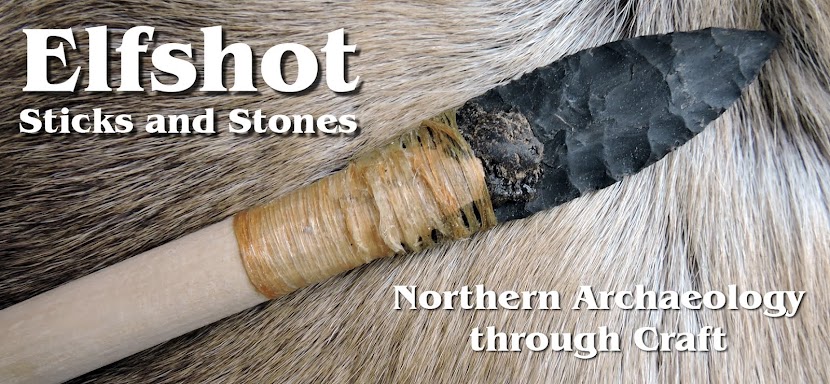 |
| Make the tool, Use the Tool |
Here are a few shots from the Flintknapping Workshop I lead in Calgary on February 27, 2011. This class was sponsored by the
Archaeological Society of Alberta - Calgary Centre - they did a great job of organizing the event and filling seats! Jason Roe's class was bursting at the seams with folks wanting to learn how to knap stone tools. My session was for people who already had some knapping experience and wanted to be challenged with something new. We made knapped stone drill bits, hafted them onto wood shafts and used them to drill slate and wood to make ground stone ulus.
 |
| The finished chert drills and the ground stone ulus made using them |
I've known about this course for 6 months and it kept me up more than one night trying to figure out a theme that would be interesting for the participants and challenging, but not overwhelming or frustrating.
Last year we made hoko knives in the morning and then used them to carve handles for other knives and points in the afternoon. I'd debated doing something with ground stone, but it was a flintknapping course and I wasn't sure how to bring in the flintknapping angle until just a few hours before I flew out to Calgary. I got out of bed in the middle of the night and went out to the workshop to pack my bow drills.
 |
| Nephrite and chert (middle) drills |
My toolkit is a little biased towards nephrite drills inspired by Thule and Inuit artifacts from Labrador, but the first drills that I learned to make were the knapped "T" shaped bits found on the plains. Sometimes the archaeological specimens are made on old projectile points and when you are first learning to flintknap arrowheads its not uncommon to make lots of of accidental drillbits. If you are having a tough time thinning your arrowhead and it gets narrower faster than it gets thin, it will wind up looking more like a drill than a projectile point.
Everyone made a drillbit first thing in the morning and hafted it onto a square wooden drill shaft using 5 minute epoxy and artificial sinew. We used the epoxy to create a quick, solid bond so that we could use the drills immediately after they were made.
 |
| The ulu blanks and handles roughed out |
When I do ground stone workshops with kids, I cut the ulu blanks ahead of time and the kids just file an edge on them and drill the holes. With this class we started with the same Home Depot 12 x 12 slate tiles, but the participants prepared their own blanks. We split the tiles to a good thickness using a hammer and chisel and then everyone trimmed their ulu blanks by carefully chipping the edge unifacially with their hammerstones against wooden anvils. After the blanks were made, everyone filed their blades sharp, used their drills to sink holes through them and then tied them to their carved wood handles with sinew and hide glue.
These workshops are pretty loosely structured and people work at their own pace, but I like the format of making a simple tool from scratch in the morning and then using the first tool to make a second, more complex tool in the afternoon. That's worked for the past two years. I think arrows or spears with foreshafts might be a fun plan for a future session. Although there's still lots of ground stone options and we were even joking about moving up to copper - after all we've moved from the palaeolithic (knapping) to the neolithic (ground stone) in just 12 months, so we could just keep on rolling into the chalcolithic (copper).
 |
| I had a great time! |
On a personal note, I was really happy to have Don Hanna attended the workshop. Don taught me how to knap back in the mid-1990s when I was an undergrad at the University of Calgary. It was really great to sit down and chat with him about knapping again. At one point someone at the opposite end of the room was talking about how to hold a biface for knapping and we overheard; "See, Tim hangs it over his knee and Don does it the same as Tim..." Don barely glanced up, but he said; "No. Tim does it the same as Don, not the other way around. And Don does it the same as Don Crabtree." With everyone's pedigree established, we went back to work.
Photo Credits: Michael Turney






No comments:
Post a Comment